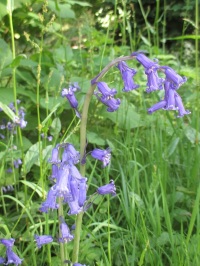 “Yes, the estate remains open until dusk. But I’m afraid the bluebells are almost over.” The National Trust staff member looked genuinely crestfallen that we had perhaps made a futile journey. I wondered too. Had we left it too late? Not in the time of day – I had deliberately chosen late afternoon just as the main house and gardens were closing – but in waiting so late into the spring? The bluebells have been magnificent this year; we still had plenty at home. But had I left it too late to see them in their true glory – massed amidst spring woodlands?
“Yes, the estate remains open until dusk. But I’m afraid the bluebells are almost over.” The National Trust staff member looked genuinely crestfallen that we had perhaps made a futile journey. I wondered too. Had we left it too late? Not in the time of day – I had deliberately chosen late afternoon just as the main house and gardens were closing – but in waiting so late into the spring? The bluebells have been magnificent this year; we still had plenty at home. But had I left it too late to see them in their true glory – massed amidst spring woodlands?
I had not. It’s true that they were perhaps just past their best but that did not detract from their beauty. To walk in these woods on a soft, sunshine-filled evening late in May was sublime.
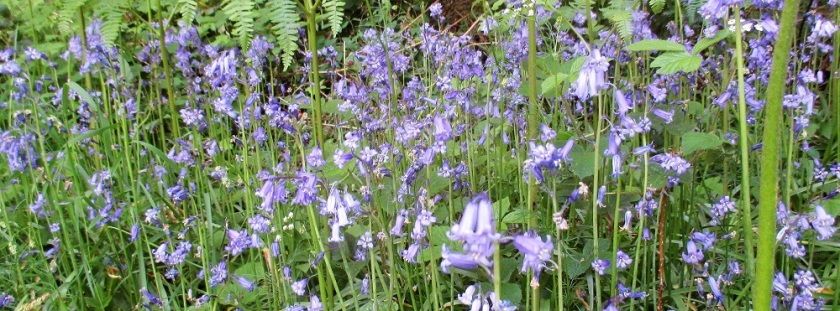
We were the only two people in the wood: we were the only two people in the world. The further in we walked, the further apart we drifted. Until each of us was alone – until it was just me. Suffused with the delights of nature, turning instinctively towards the reverent solitude of a sacred space.
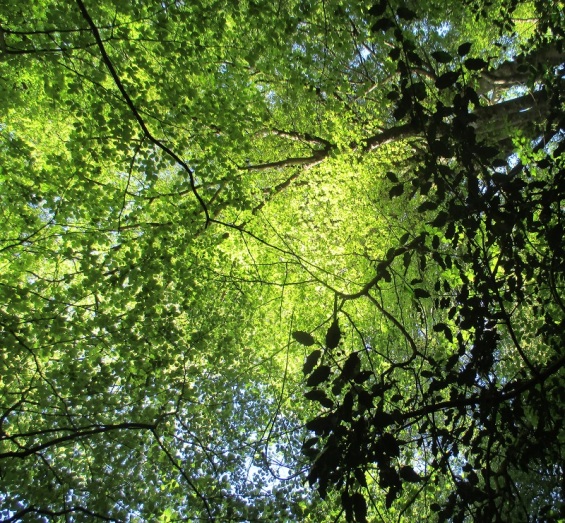
Light – bright and clear – streamed through the canopy. Leaves shimmered and sighed, a mosaic of emerald supported by ancient pillars – venerable trunks stretching upwards and sending graceful branches to weave an intricate lattice high above the floor and just below the heavens. The breeze sighed; the trees soughed softly in response and hosts of birds near and far sang a celestial symphony which rang pure and deep into the furthest corners.
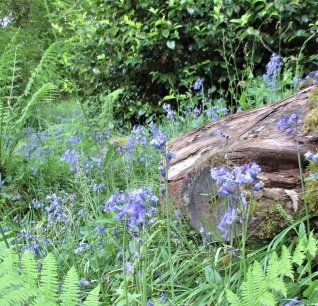
And on the woodland floor, everywhere there were bells, fading bluebells. Drifts of hazy blue clustering around ancient trunks, broad, riven and gnarled. Younger brethren, grey and smooth, and moss-covered logs – all were islands in a carpet of blue. How many blues can a bluebell be? In stretches of balmy shade they massed sedately in tinctures of deep heather and ecclesiastical purple. They crowded into splashes of evening sunlight dressed in smoky lavender and dusky lilac and in spotlights of brightest, lightest sunshine they danced in accents of cobalt and indigo, azure and regal royal blue.
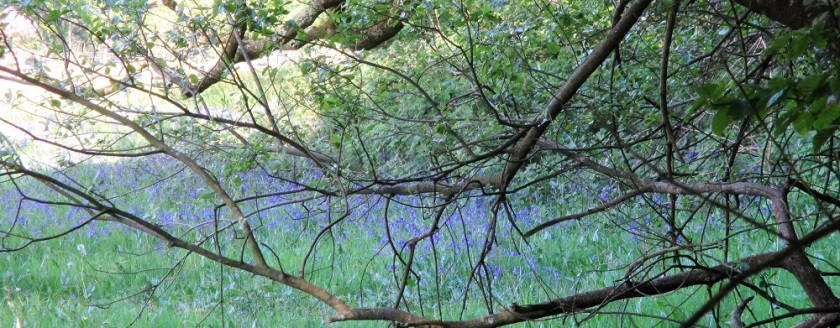
An endless cerulean ocean, the pure notes of an avian chorus and the soaring green vaults of this, the most natural of cathedrals. A paean to an English springtime.

A few days later, I came across this poem by Mary Oliver:
When I am Among the Trees
When I am among the trees,
especially the willows and the honey locust,
equally the beech, the oaks and the pines,
they give off such hints of gladness.
I would almost say that they save me, and daily.
I am so distant from the hope of myself,
in which I have goodness, and discernment,
and never hurry through the world
but walk slowly, and bow often.
Around me the trees stir in their leaves
and call out, “Stay awhile.”
The light flows from their branches.
And they call again, “It’s simple,” they say,
“and you too have come
into the world to do this, to go easy, to be filled
with light, and to shine.”
I shall try to remember the message of the trees.

A beautiful post! I love the simplicity and love of all natural things to be found in Mary Oliver’s poems – very special. 🙂
LikeLiked by 2 people
Thank you 🙂 Her poetry is indeed special. So accessible yet able to touch that deepest part of us.
LikeLiked by 2 people
Exactly so. 🙂
LikeLiked by 1 person
Here we have meadows full of scilla which produces a similar astonishing delight. A friend and I have a two person book club and we have been reading Mary Oliver’s compilation “Devotions” each week. Very calming poems encouraging each of us to just look around.
LikeLiked by 2 people
Yes, I can imagine meadows of scilla would be equally wonderful. Elizabeth, I am reading ‘Devotions’ at the moment which is where I found this poem. (Originally from her 2006 collection called ‘Thirst’.) I agree – her poems are deeply calming and we can learn a lot from her message.
LikeLiked by 2 people
We are reading her collection back to front so we can watch her develop as a poet.
LikeLiked by 1 person
Yes! I wish the book had been presented in that way.
LikeLiked by 1 person
It is really enlightening to read it that way.
LikeLiked by 1 person
The beauty of your writing made me pause and retread those lines just as the trees sough and beckon under the cerulean light.
LikeLiked by 2 people
Thank you, Uma. I am happy to have captured that evening walk. It was very special 🙂
LikeLiked by 2 people
Bluebells are possibly my single most favourite thing about Britain – I am so glad you got an eyeful of them, even if they were just a little past their best!
LikeLiked by 2 people
I’m glad too, Marina. There are occasions when things come together to create something particularly special and this was one of those times.
LikeLiked by 1 person
It is one of life’s absolute joys to walk through carpets of bluebells – what a memorable experience you had. And that poem is perfect – Mary Oliver has such a wonderful way of capturing the beautiful essence of nature.
LikeLiked by 2 people
Doesn’t she just! Her poems are so simple and accessible but with such impact. And yes, this was a truly memorable experience. One I’m glad to have captured 🙂
LikeLiked by 2 people
I’ve never seen bluebells, although I guess they grow in the US. But your description helps me to understand what their power and beauty can be.
LikeLiked by 2 people
I think it’s a combination of their colour and the timing of their display which gives them such resonance for most of us over here. That sea of blue after the grey winter. A bluebell wood does seem to be a particularly British thing, although I’m sure they must grow in many places in the world.
LikeLiked by 1 person
They do. We (allegedly) had bluebells in France. But the special lambent beauty of an Englsih bluebell wood is unknown. Spanish bluebells don’t drift, don’t have the very special smoky blueness, so very hard to capture in photos (and haven’t you done well with yours?). And anyway, you know what I think of Spanish bluebells, Sandra.
LikeLiked by 1 person
Lambent is a wonderful word – so very apt 🙂
LikeLiked by 1 person
A poetic post, where prose and pictures went hand in hand. I almost felt I was there. Loved it! 🙂
LikeLiked by 2 people
Glad you enjoyed it 🙂
LikeLiked by 2 people
There’s not much more sublime. Beautifully described as always
LikeLiked by 2 people
Exquisite, Sandra. You have captured the essence, as always, of that most sublime of experiences- bluebells in an ancient English woodland. They have been early, prolific and somewhat fleeting this year, and I was lucky enough to catch them as you did , rather late, in Evenley Wood. We saw no one else in the wood that day. Sheer magic. xxx
LikeLiked by 2 people
Ah, Evenley Wood – I can imagine it would be very similar there, Pat. A beautiful spot and on the doorstep. I’m glad you got to enjoy some spring moments there. Food for the soul as much as a feast for the eyes 🙂 xx
LikeLiked by 1 person
A feast indeed.
xxx
LikeLiked by 2 people
Our local bluebell wood, Coed Cefn (‘Ridge Wood’) is a minor miracle in late spring, especially when — as for you — there are fewer visitors, and especially those who let their dogs blunder through the drifts, bludgeoning unnecessary paths and destroying what we’d come to see. I like it best when one gets the impression of a blue mist carpeting the ground in the middle distance.
https://wp.me/s36La9-picnic
Enjoyed your photos, Sandra, very atmospheric, and amazing to know that there are still a few bluebells lingering around this late in the year. A lovely text too — I’ve read very little by Mary Oliver and ought to remedy that.
LikeLiked by 2 people
A secret blog, Chris – at least new to me 😉 Thank you for pointing me towards it, beautiful bluebells there!
LikeLiked by 1 person
You’re very welcome 😊
LikeLiked by 2 people
True English bluebells. Wonderful! 😊
LikeLiked by 2 people
I was looking closely – definitely english bluebells, Paula 🙂
LikeLiked by 2 people
Mary Oliver is absolutely one of my favorites and this poem fits in so nicely with your pose. Thank you for taking us along on such a beautiful evening!
LikeLiked by 2 people
You’re very welcome, Laurie! Thank you for coming along! 😀
LikeLiked by 2 people
Bluebells under the young green – it’s such a special time and why not enjoy it when they are fading too? There’s something lovely about catching the last glimpses – like a poem in itself. Incidentally, I bought some British bluebells this year and was put out to find they were not the native ones, where the bells hang on one side of the stem and curve so beautifully. For once I should have asked for ‘English’ though bluebells are everywhere in Britain as far as I know.
LikeLiked by 1 person
Yes, I’ve wondered about the ‘english’ epithet. Why not british bluebell? Then I think about welsh poppies and retire in confusion! With so much hybridisation now between the english and spanish bluebells, I do get a special pleasure from the true english bluebell. Deeper colour and as you say, that graceful curve.
LikeLike
Welsh poppies are lovely! And yellow. I brought some seeds from Wales but can’t find them now. Must try again. I have never seen them in England.
LikeLiked by 1 person
Oh really? Not seen them in England? Now I come to think about I’m wondering myself. I was sure I had seen them but where and when eludes me. I hope you find the seeds. You might be introducing them here!
LikeLiked by 1 person
I have Welsh poppies in my garden in Oxfordshire- they seed about quite prolifically and sometimes the flowers are tinged with orange. I have no idea where they came from, other than seeds from a friend’s garden in the village!!xxx
LikeLiked by 2 people
Sounds good. I suppose I meant I hadn’t seen them in the wild. But there’s no reason why they shouldn’t thrive in Lloegr. I hope to help spread a yellow revolution one day.
LikeLiked by 1 person
Lovely – and I’d so love to see those bluebells one day!
LikeLiked by 2 people
Definitely worth seeing, Spatz!
LikeLiked by 1 person
Beautiful! 🙂
LikeLiked by 1 person
🙂
LikeLiked by 1 person
Your photos and writing are beautiful Sandra. So hard to capture the light and shade and the depth of blue, but your photos do that as do your descriptions, which are deeply felt. I should think that old cathedrals were partly inspired by forests and woodlands and now they are sacred spaces that cross-pollinate in our imaginations as your post conveys so well. The poem too is reassuring. Thank you.
LikeLiked by 2 people
You’re very kind, Carol 🙂 My photos are almost the antithesis of your own. You have such patience; I point and shoot. But I’m often pleasantly surprised at what I capture.
LikeLiked by 2 people
Quite lovely. I’ve just looked up Mary Oliver, and discovered she wrote other beautiful pieces, too. Thanks for that pointer. Your photo’s are gorgeous.
I don’t count bluebells as being over until the last ‘bells’ have fallen, and those certainly still had a lot of lovely colour. Wonderful.
LikeLiked by 1 person
Thanks, Cath. Enjoy Mary Oliver!
LikeLiked by 1 person
Wow! Hauntingly beautiful, captivating and mesmerising as always!!!!!!!!!
LikeLiked by 1 person